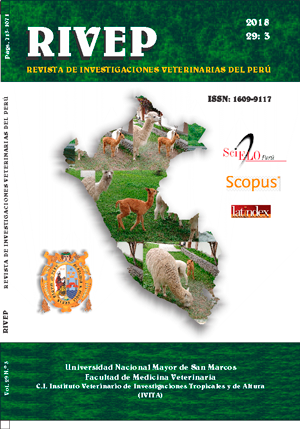Detection of canine parvovirus type 2 (CPV-2) by PCR in dogs from Lima, Peru
DOI:
https://doi.org/10.15381/rivep.v29i3.14771Keywords:
canine parvovirus, rectal swabs, clinic diagnosis, PCRAbstract
The objective of the study was the detection of canine parvovirus type 2 (CPV-2) in young dogs of Lima city with and without clinical symptoms compatible with parvovirus by the PCR technique using primers that can allow the amplification of a fragment of the gene coding for the protein VP2. Rectal swabs were collected from 78 dogs younger than one year old and without a history of previous vaccinations, of which 39 individuals had a clinical diagnosis of canine parvovirus and the other 39 were clinically healthy animals. For the extraction of viral DNA, the fast boiling method was used. Samples were boiled at 100 °C for 10 minutes and then centrifuged to extract the supernatant, which was used as a template for the PCR reaction. Specific primers that amplify a 1316 base pair fragment of the VP2 gene of the CPV-2 virus were used, using a commercial vaccine as a positive control. The virus was detected in 62% of animals with clinical diagnosis of the disease with conventional PCR, not being detected in clinically healthy dogs. The non-detection of CPV-2 in animals with a clinical diagnosis compatible with parvovirus in 38% of cases would indicate the presence of another etiological agent as the cause of the clinical signs, and therefore, recommending the use of complementary techniques for the correct diagnosis of the disease.Downloads
Downloads
Published
Issue
Section
License
Copyright (c) 2018 Raquel Quino Q., Rocío Rímac B., Luis Luna E., Lenin Maturrano H., Raúl Rosadio A.

This work is licensed under a Creative Commons Attribution-NonCommercial-ShareAlike 4.0 International License.
AUTHORS RETAIN THEIR RIGHTS:
a. Authors retain their trade mark rights and patent, and also on any process or procedure described in the article.
b. Authors retain their right to share, copy, distribute, perform and publicly communicate their article (eg, to place their article in an institutional repository or publish it in a book), with an acknowledgment of its initial publication in the Revista de Investigaciones Veterinarias del Perú (RIVEP).
c. Authors retain theirs right to make a subsequent publication of their work, to use the article or any part thereof (eg a compilation of his papers, lecture notes, thesis, or a book), always indicating the source of publication (the originator of the work, journal, volume, number and date).



